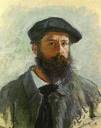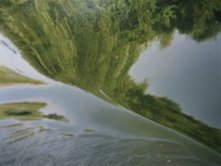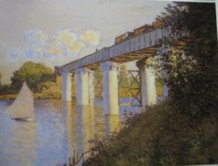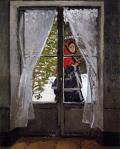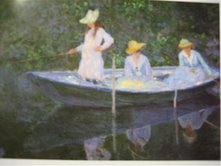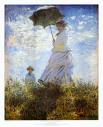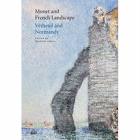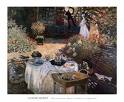
![]()
|
Index
•
|
|
Welcome
•
|
|
21st Century•
The Future |
|
World
Travel•
Destinations |
|
Reviews•
Books & Film |
|
Dreamscapes•
Original Fiction |
|
Opinion
& Lifestyle •
Politics & Living |
|
Film
Space •
Movies in depth |
|
Kid's
Books •
Reviews & stories |
|
|
|
|
The International Writers Magazine Art and Photography:
Did an oil slick inspire Monet’s Pond Lily Paintings?
• David Russell
Focusing my 300 mm lens at the Oise River shoreline we were hugging to avoid the wakes created by tankers and freighters ten times our size and moving twice as fast as our 18 passenger tourist barge, I noticed something I would never had thought of twice, had our tour group which was partly leisure and partly studying French Artists, not seen a slide show and tell about Monet just two hours earlier.
That morning we had departed Auvers, leaving the memory of Van Gogh behind, and were now motoring to a landing where a waiting bus would deliver us to Monet’s Giverny home. I had big plans there. I would address Monet’s garden and pond paintings with my 35 mm camera, in an attempt to match my lens openings to what I imagined were Monet’s framings, while also trying to match the time of day and light condition of his painting hours. Perhaps it was all that information coming together that led my thinking as brought my close-up lens into sharp focus. What caught my eye was an oil slick rotating in a slow eddy dance which continued to catch the sun at different angles creating a spectrum of revolving colors and shapes; like a never ending cycle of impressionistic canvases. -During our lecture, we learned that from his birth in La Havre, sea port for local and International shipping, Monet was fascinated by water subjects.
Looking at his body of work, it would seem that everything he saw that was water related found their way onto his canvases: boats, ports, shorelines, stormy and calm waters; with obvious palette changes as he matured. In his later years, Marcel Proust applauded Monet’ with these lines: "...there would be not flowers on earth, but also flowers of the water, such tender water lilies as the Master has depicted in his sublime canvases." Early samples of Monet’s fascination with water themes were "The Pointe de la Heve at Low Tide’". "The Mouth of the Seine at Honfleur" and "The Beach at Saute – Adresse.". Each canvas revealed a hard edge with strokes bold and heavy from a far darker palette, than found in his later years. When he returned to Paris seeking La Salon approval, that same hard edged look and broad strokes was seen, especially in his fine character study "The Woman In The Green Dress" which earned him ready approval.
His interest, however, soon turned from character studies to landscape. First, without and then later, with people added. All were done in his studio until the impressionist Plen Air movement attracted him to try his hand at painting outdoor scenes in their natural environment. Monet, who preferred working on enormous canvases, in studio and out, displayed his Plen Air skills with his "The Green Wave". There were no waves along my shoreline as I continued to stare at the moving water, watching it spiral in and out of the sun, as if they were paintings being made, one after the other, being stroked by an invisible hand with an invisible brush.And this is the key to my story.
Photo: David RussellI considered that Monet traveling between his home and Paris, a half day’s journey, given the choice of going overland or by river boat would chose the boat. Part of my reasoning was because to paint another water scene slide I saw that morning "La Grenouillere",
Monet had taken his easel into the river, working from the deck of a small boat. So the $64,000 question? Had Claude Monet, while on the river that day or in his water travels seen a swirl of water and light such as I was now watching. If so, I had to believe these impressionistic swirls - intended or not - influenced his creative bent and drove his brush to its impressionistic replication. But many stops filled the early yeabefore he arrived at that moment. After his Paris stay, Monet moved into his first real house, at Argenteuil, Becoming accessible from Paris on the new, French railway system. Argenteuil provided Monet a fertile area to continue his systematic pursuit of how various architectural shapes were altered by the influence of light and water. A result being "The New Railway Bridge". The water in that canvas conveys a softer, less edgy look, precursor to what was to come.From Argentuil, Monet returned to Paris to financially trade on his growing reputation. There, his large railroad station, flag draped boulevard on Bastille Day and other works brought both recognition and reward. Once his monetary goal had been met, Monet returned to his first love, painting water. His second house actually on the banks of the Seine at Vetheuil, drew this letter to a friend, "You may have heard that I pitched my tent on the banks of the Seine at Vetheuil, in a ravishing place.".
But Vetheuil proved not to be a wonderful place; his wife Camille died suddenly. Though, that year, the river became the subject of a series of winter landscapes, these canvases were filled with remorse, an end to his youth and coming at a time when the Impressionist movement was on the wane.But by 1883, it was a much different, more optimistic Monet, as he moved into his new house in Giverny, enthusing that the area was "Splendid Country For Me. I am in Ecstasy". Giverny, about 40 miles northwest of Paris at the junction of Epte and Seine river, obviously suited him because seven years later he bought the property, declaring that he was "certain of never finding a comparable house nor such beautiful countryside anywhere else."
Image: Camille Monet
After Camille’s death, Alice Hoschede, his housekeeper, married to Monet’s business manager, moved with him to Giverny saying she had to look after Monet’s two sons, while husband, Ernst stayed in Paris "on business". Not only did his domestic scene change, his painting style did as well.
Now he preferred lighter paint tones and softer brush strokes. In a painting of Alice’s daughters, the blue & white dressed girls are echoed by muted water reflections in "Boat at Giverny"
Yet, as much as he enthused about Giverny, finally and permanently settling took many years. No sooner had he moved in, than he took his first away, journeying to meet his friend Renoir on the Mediterranean Coast. What he saw there so impressed him, he soon returned, spending 3 months "painting alone" in tropically vegetated Bordighera, just across the Italian border. In a letter he told Alice that he desired to paint "...the orange and lemon trees standing against the blue sea". Which he did time and again. Following his Mediterranean stay, in a quest for new water to study and put on canvas, Monet moved to the Brittany Coast. lodging in fisherman’s quarters. There, he put his hand to capturing the wild and rocky coast. Alice received a letter saying "I know that to paint the sea truly, you have to see it everyday at all hours and at the same spot, so you get to understand the life of it at that spot; so I do the same subject sometimes four or even six times over.."
Of his Brittany work, Monet successfully sold 10 canvases to Theo Gogh, something brother Van never did; selling not a single painting in his lifetime. Art critic Felix Feneon in his Revue Independante column titled the paintings "Ten Antibes Seascapes". Later Monet learned that the show "...really won over the public, mulish as it is."
From that day forward, Monet began grouping his paintings as Feneon had, concentrating on showing paintings of a single location from multiple viewings. Moving to the Cruese Gorge, he did nine seascapes of the same subject varying his painting hours from dawn to dusk.Returning home, he turned his hand to capturing images of the local waters and small boats, such as in his "Study of a Boat", and "Boating at Giverny", again showing the three Hoschede sisters.
Continuing his studies in the effect of light and the use of color, Monet painted fields and trees including his famous hay stack series. Compared to his earlier bold, rugged, hard edged Brittany Coast paintings his work ""Cliff at Varengeville" is a luminous canvas of yellow grasses and a blue sea muted with blended lemon grass tones. In another stray away from Giverny, he traveled to Venice where he wrote Alice that he adored the glorious light on the canal, adding almost as an afterthought that "I pine for Giverny. Everything Must Be So Beautiful There In The Glorious Weather". Back in real time, our motor barge had slowed and was about to dock, so, for perhaps the third time that day, I wiped clean all of my camera lenses, double checked what were a new set of batteries, both for camera and flash plus a back-up camera as well. Then, finally I double checked to be certain each camera loaded with fresh film rolls was ready. But, I needn’t have rushed; the bus ride including a box lunch was a full 2 hours. When we finally arrived, the path from the bus to the house provided our first look at the garden so carefully nurtured by Monet and Alice.
Its present caretaker was less caring; if anything the garden looked overgrown riot of color.The house was filled with Japanese prints and copies of Monet art, which we later learned came from a thriving on-site retail outlet that sold prints of all sizes to visitors plus shipping great quantities to sources world wide. Monet had no idea how successful he had become. As it turned out, our group was allotted one hour at the pond, so my dream of matching different light at different times of the day went out the window.
Monet's GardenWith and without flash, I did expose six rolls of 100- 800 ASA of Fuji professional stock. Deliberately, moving around the pond I worked at catching shadows and light, snapping the bridge with and without fronting foliage and people, while taking multiple exposures of 9 – various lily pond arrangements. I did my diligent hour until the leader hoarse from her efforts, finally pulled us away, through the required retail store stop then back on the bus, delivering us at our barge by 7:45PM, a bit late for our cocktail hour, but we made up for missed time.The balance of our cruise took us through the French locks system moving us up in water height lock by lock till we reached Paris.
here, we had our Louvre visit, saw the Museum of Impressionist Art and the Musee de Orsay, enjoying many Van Gogh and Monet works. And, as is mandatory in Paris, ate and drank more than our fair share of the best it had to offer.Back home, by my third day, I was impatiently waiting for the lab to complete processing my film. Then, finally, with the prints in hand, I could compare my attempts to paint with my camera what Monet had painted with his brush. What I was sure of, was that I knew more about French art and artists from the l800-l900 period then I did before our trip. Also I had a better understanding that to be a true artist -- in art, dance, music, theatre – no one succeeds without a lot of invested time, energy, loving care, lots of sweat and a bit of luck.
All words which ring true. Plus that one unique ingredient – true talent. I’m smart enough to know though I love taking pictures, a photographer I’m not. Monet I certainly am not. But what I am – I believe, is in good company.
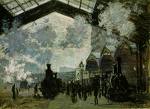
© David Russell September 2008
(druss811@verizon.net)© Hackwriters 1999-2008
all rights reserved - all comments are the writers' own responsibility - no liability accepted by hackwriters.com or affiliates.

